By the time late February comes around in Denver, Colorado, I’m usually more than ready to get started planning my vegetable garden for the summer. While there are still a few months of cold weather to go before I can begin growing things outside, March is usually when I start planting seeds indoors for my vegetable garden.
There is something about watching new, green seedlings start to grow, even if it’s just happening in my windowsills. Starting seeds indoors usually holds me over during the remaining scattered days of early spring snow and colder temperatures.
While I’ve only been starting vegetable seeds indoors a few years, I’ll share with you some of the things I’ve learned about selecting vegetable seeds the supplies I’ve used to successfully start some of my vegetable plants inside.
How Do I Choose Vegetable Seeds for Starting Indoors?
There are many types of seeds to buy both online and in the hardware stores. I usually like to go the most economical route for buying my seeds. Buying individual packets of seeds at Home Depot and Lowes starts to add up in cost. So for the past couple of years, I’ve been buying these Assorted Vegetable and Herb Seed packets. They are GMO-free, heirloom seeds with a high germination rate. Just know that you don’t get the exact packets of seeds shown in the photo when you order. It’s a random selection of packets, but they come with a good variety of vegetable seed choices.
I like having the option of choosing what to grow from multiple vegetable seed types. I’ve found that initially I don’t expect to use some of these packets. But what’s fun is that I end up discovering that it forces me to try planting new things which I wouldn’t have considered simply because I have them in my possession.
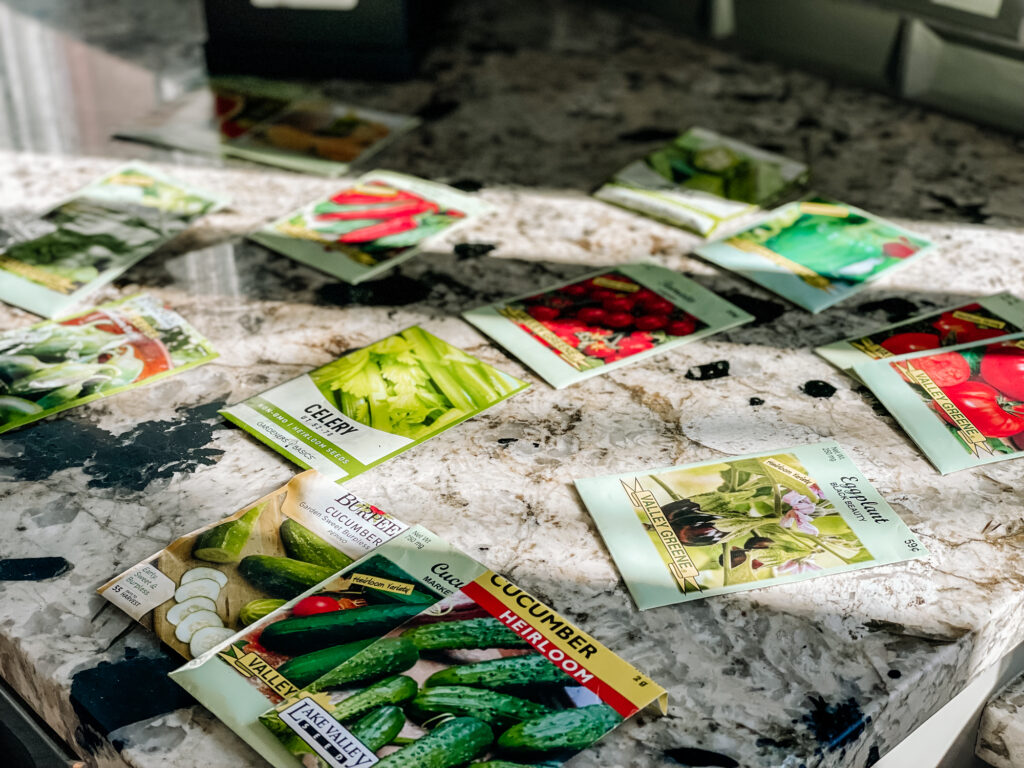
Which Types of Vegetable Seeds Will Germinate Well Indoors?
Knowing how to plant seeds indoors is only part of the equation. It’s also good to know which vegetables might do well starting from seed in an indoor environment. Again, for me, this is often trial and error. But what I’ve found usually grow quickly and easily inside are cucumbers, squash, tomatoes, broccoli and peppers. I’ve also had some success with sprouting herbs inside. I’ve not had luck with lettuce varieties. For me, they’ve gotten leggy grown indoors and since spinach and lettuce are some of the earliest seeds you can plant in your vegetable garden in the spring, I find it best to just wait and sow in the ground.
However, I’m still always learning and trying new things. So every year, I always try planting a few vegetable seeds in that I’ve never tried starting indoors. This year, it’s cantaloupe, watermelon and even carrots for me! These are all things that take a long time to mature in Denver. So while I have no expectation these will work indoors, I might just be pleasantly surprised with some success. And if not, it wasn’t a pricey mistake to make!
What Materials Do I Need to Plant Vegetable Seeds Inside?
The first year that I started seeds indoors I used regular potting soil and leftover egg cartons, jars and salad containers as my seed-starting “pots”. I filled each compartment of the egg carton with dirt or the bottom of the plastic salad container with soil and sowed my seeds. Plastic egg cartons and salad boxes helped because using their lids created a mini green house effect. I simply placed these in a south-facing or sunny window, and I did get some things to sprout.
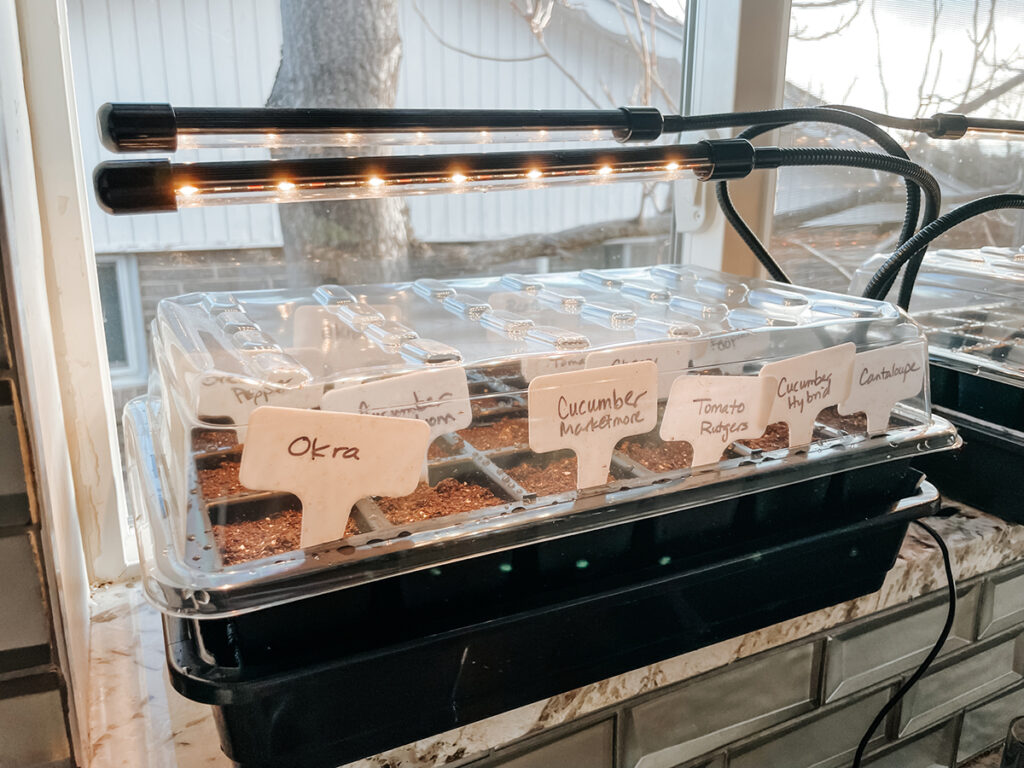
Using Indoor Grow Lights to Encourage Germination
As years went on, I gradually starting buying other items to help my indoor vegetable seedlings grow. Indoor grow lights were a game changer for me. And you don’t have to buy a large or expensive version of them to have success. I’m still using a very basic set of indoor grow lights that give just the right amount of consistent light to encourage seeds to sprout indoors.
This season, I’m using two sets of lights (both shown below) which have timers so they automatically go and off. The first indoor grow light for plants I bought has a clip and 4 arms. I like this one because you can bend the arms to go closer to certain plants. Or, if you have trays of seeds on two shelf levels, you can angle them to each level. It’s also good to set near a houseplant in the winter that maybe could use a little more light on cloudy days.
The other set of grow Iights I bought is great because they are individual light strips that can stick to the underside of a shelf above your seedlings. This year, I’m setting these grow lights right on top of my seed starting trays.
Seed Starting Trays to Keep Seedlings Organized
My mother-in-law gifted me a great set of seed starting trays this year from Gardener Supply, so I’ve started my seeds in these this year. I found some similar seed starting trays on Amazon which should work great also.
This will be the new way I start vegetable seeds indoors from now on! I’m loving using the trays instead of individual containers because it’s a much more compact setup and requires less room in my home. Each tray holds 24 plants and can fit in my windowsills. With individual tiny containers, it wasn’t as easy to water without knocking them over. Here, in these trays, everything is together as one which allows for quick watering.
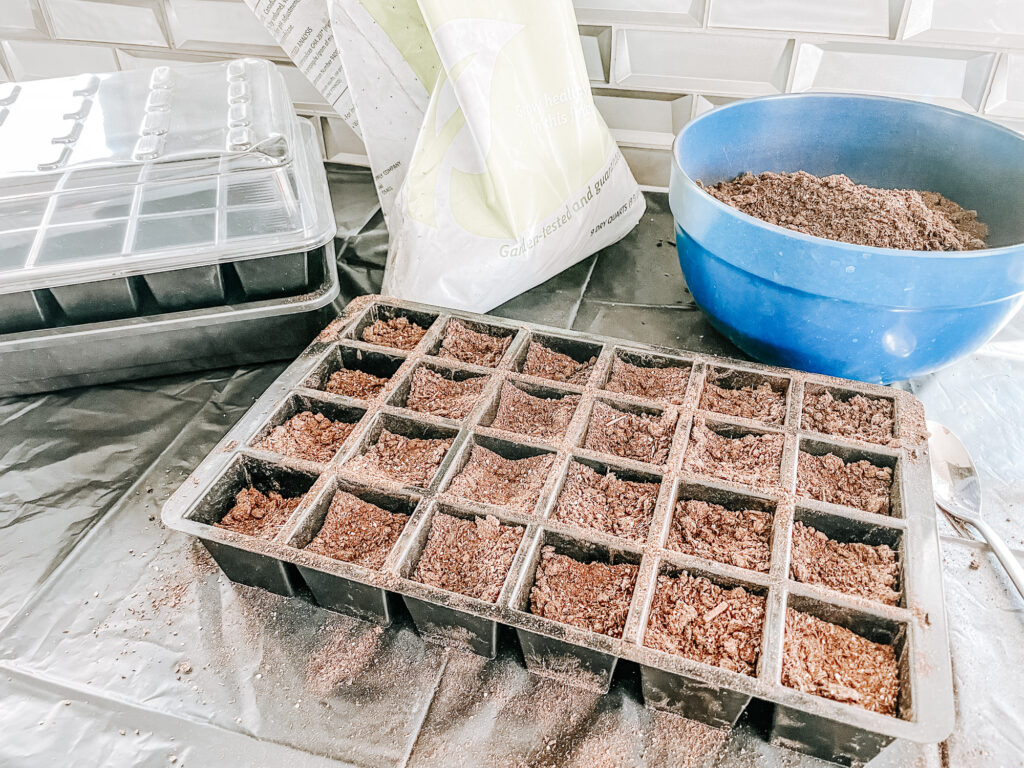
It’s Best to Use a Seed Starting Soil Mix
It’s best to use a seed starting potting soil mix to start your seeds. While I’ve definitely had success getting seedlings to grow in regular potting soil, a seed starting mix is ideal because it’s lightweight and designed to get seeds to germinate. On the other hand, regular potting soil is created to help more established plants to grow.
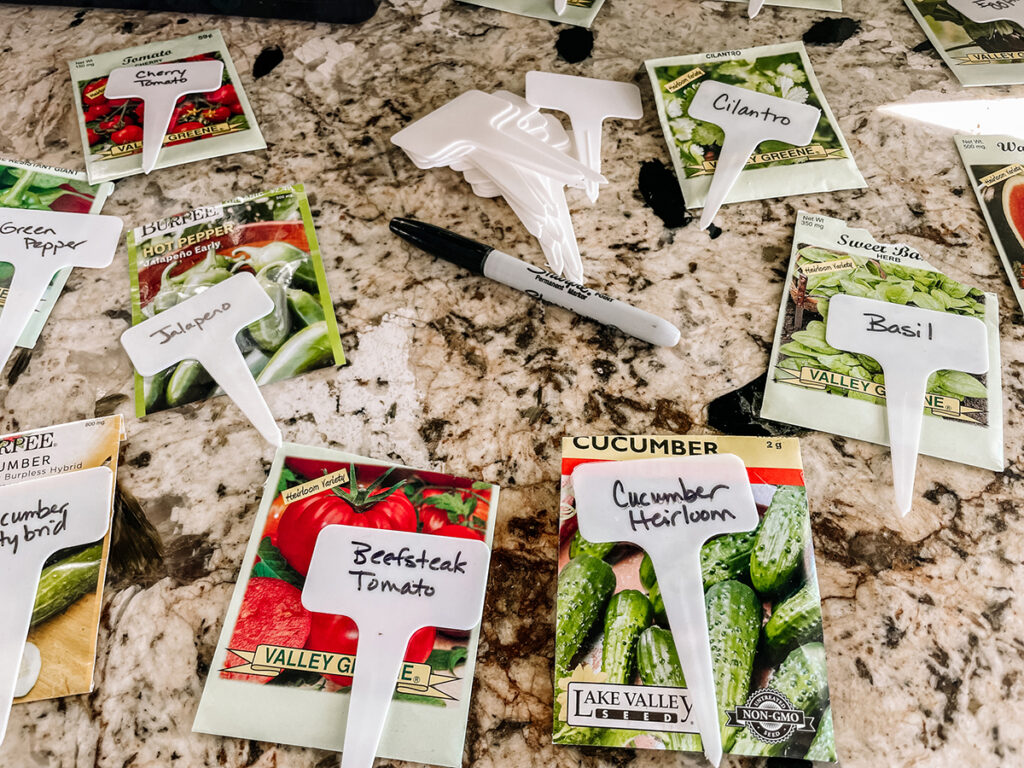
Plant Labels for Marking Soil Compartments
Once you get your seeds planted, it’s important to mark each compartment as you go along so you can remember which vegetable is growing in it. I like using these plastic plant labels with a Sharpie marker to mark my seeds. I found these can easily go from your indoor containers out into the vegetable garden with the mature plants as markers. And I reuse many of mine year after year, both inside and outside.
How Do I Fill and Water Each Soil Compartment?
Once you have all of your materials together, it’s time to start planting the seeds!
Determine How Many Plants of Each Vegetable Type You Want to Grow
Consider how many of each vegetable plant you want to end up planting in your vegetable garden. First, you’ll want to research online the average number of plants needed for the number of members in your household. Here, you’ll find information on how much fruit one plant typically produces so you don’t end up with too much of any one vegetable.
Let’s use tomato plants as an example. For my husband and I, we usually plant 2-3 tomato plants in the vegetable garden each year. Sometimes, I’ll plan two larger variety tomato plants and one cherry tomato plant. We know that we like to make salsas and even pasta sauce in addition to simply eating fresh tomatoes. So we like to ensure that we have enough in the garden for our love of summer tomatoes. So if I want to end up with three healthy tomato plants, I’ll need to plant tomato seeds in 3-4 compartments of my seed tray. I like to plant 1 – 2 over what I need in case I loose any plants along the way. And if they all take off, I can gift them to a neighbor!
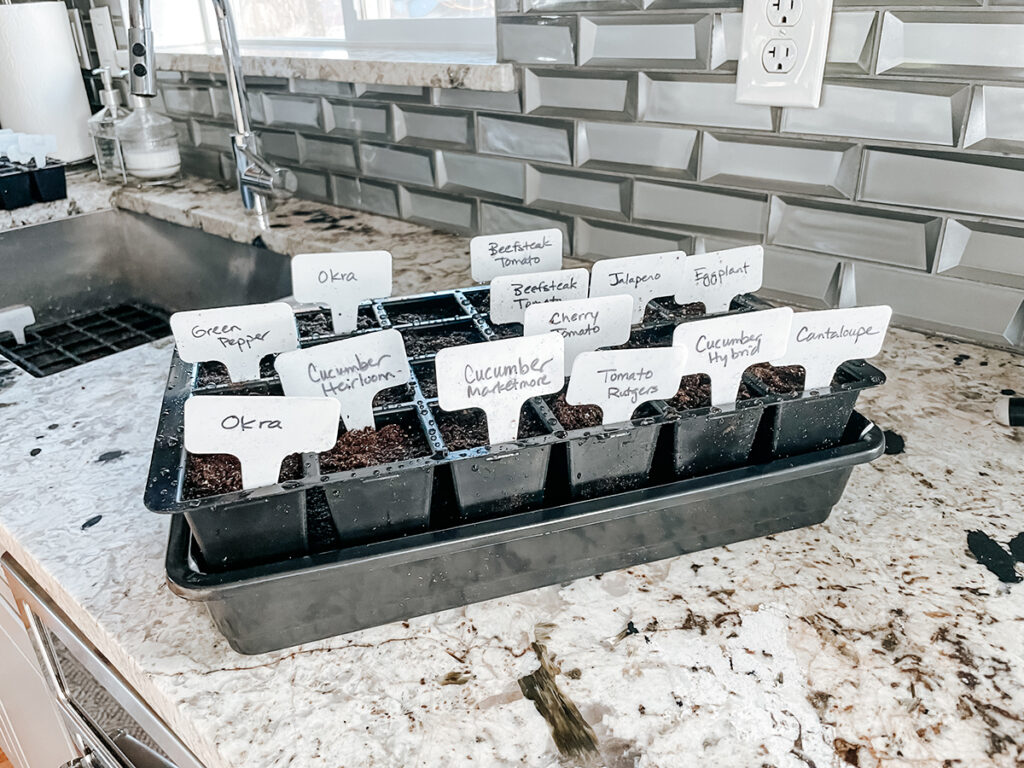
How Many Seeds to Plant In Each Seed Compartment
In each container, I usually plant 3-4 seeds of the same vegetable variety in each seed compartment of the tray. While you’ll only want to end up with one plant per container in the end, it’s good to plant a few together so you can ensure at least one strong plant will grow. As they germinate, you can determine which of the seedlings are the largest or strongest. You will pull out the smaller ones and give the one remaining strong plant the space it needs to grow.
Fill Compartments with Soil, Add Seeds & Water
Fill each seed compartment with seed starter mix about 3/4 of the way to the top. Follow the directions according to the seed packets on how deep to plant each of the seeds. Once you have the seeds in place, cover with the correct amount of dirt according to the packet. Tap down the dirt a bit in each compartment and lightly but thoroughly water. Be careful not to apply too much water pressure as it will be easy for the seeds to move and flood out of the container at this point.
Cover & Place Grow Lights Over the Seeds
If your seed compartments have a plastic cover, cover the tray of planted seeds. This will help keep moisture in and create a warmer environment to help the seeds germinate. Position your grow lights over the containers. Even though I set my trays in windowsills, I set my grow light timers to be on for 12 hours a day even while the sun is out. I want to be sure they are getting consistent daily growing light between roughy the 7am – 7pm hours.
Keep Dirt Consistently Moist Until Seeds Germinate
It’s very important to keep the soil wet after first planting vegetable seed because your seeds won’t germinate if they dry out. So check daily (or even twice daily) that the dirt is moist at least until you start to seed sprouts come up. Keep in mind this germination time varies from plant to plant. The germination time can be be found on the seed packets.
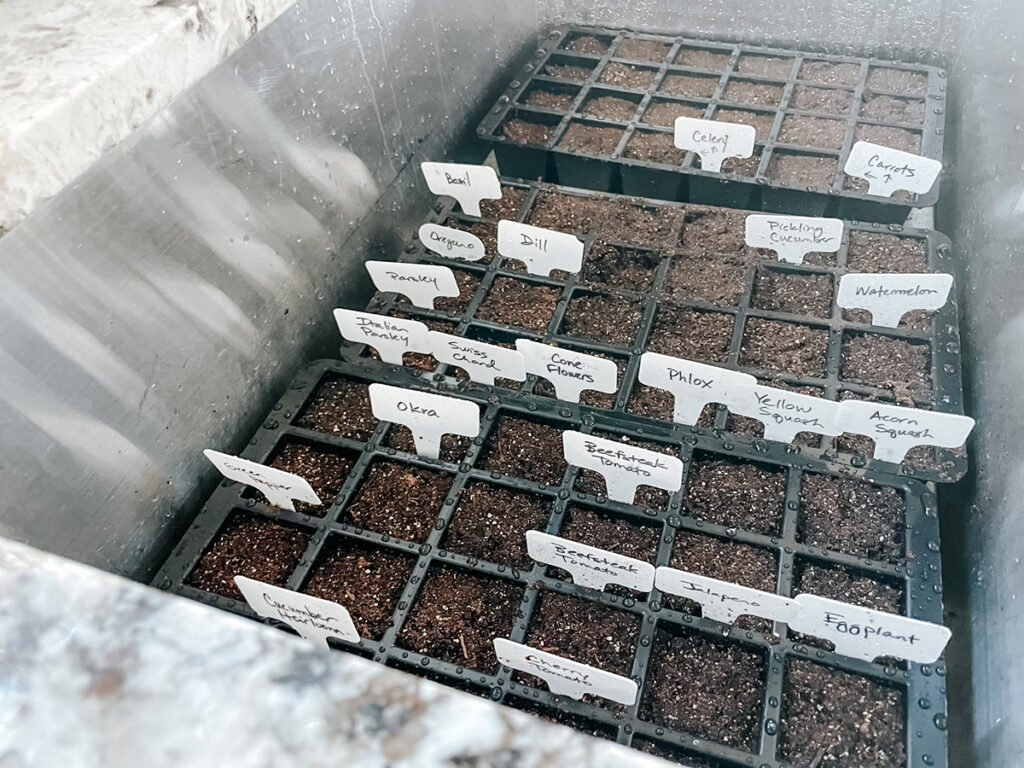
Your Seeds Have Sprouted: Here are Next Steps
Keep your seedlings consistently watered once they are growing. However, this watering often doesn’t have to be quite as frequent as it did when you first planted the vegetable seeds. Remember that if you planted more than one seed in a compartment, you need to thin these out by pulling and discarding the smaller seedlings. You only want one strong plant per compartment in the end.
You’ll take care of these vegetable seedlings indoors until you can plant them outside in your vegetable garden after the last expected frost. There is an important last step called hardening off the plants before you can place directly into your garden. This involves gradually exposing your new plants to sun and the elements (wind, etc.) so you don’t shock them. Without this last step you will loose your plants. I’ll be posting another blog article on How to Harden Off Seedlings in early Spring. Until then, you can enjoy your new seedlings indoors.
Conclusion
Having a successful vegetable garden starts early – long before those warm summer days come around when we want nothing more than to spend our days outdoors tending our gardens! Starting seedlings indoors while it’s still cold outside gives us an advantage by allowing us more control over growing conditions while also saving us money compared to buying starts from nurseries. Choosing appropriate seeds for our climate zone and preparing our soil ahead of time also sets us up for success later on down the road when we finally get around to planting our vegetables! With these tips in mind hopefully everyone has a fruitful season full of fresh produce coming their way this summer!





